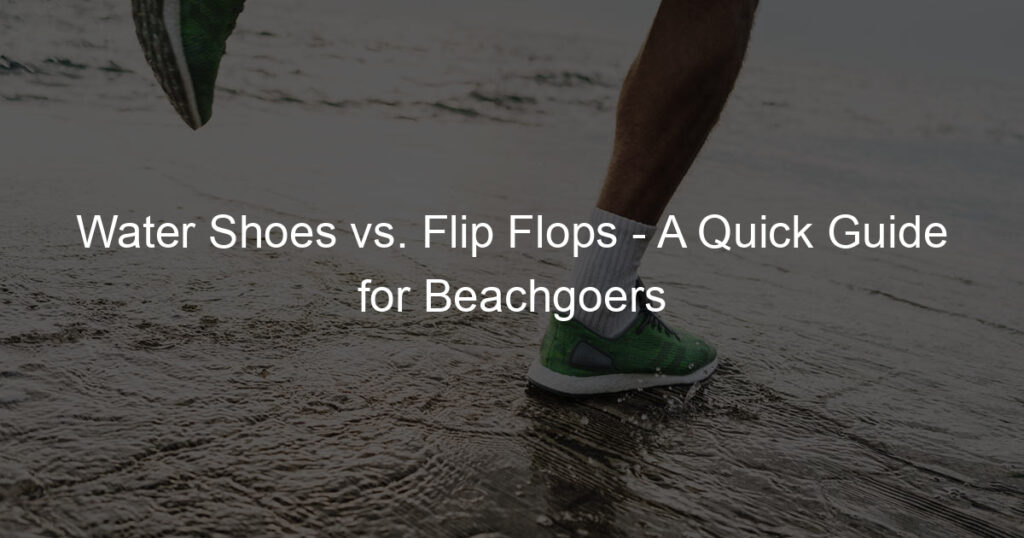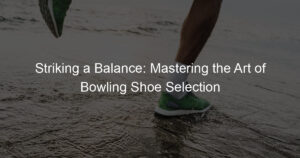When it comes to footwear for the beach or water activities, the age-old debate of water shoes versus flip flops continues. I’ve always been curious about which option is better for different scenarios and situations.
So, let’s dive into the world of Water Shoes vs. Flip Flops, examining their features, benefits, and drawbacks.
Water shoes are designed specifically for activities in and around water, offering support, protection, and grip. Meanwhile, flip-flops have been the go-to casual footwear for beachgoers and poolside loungers, prized for their simplicity and convenience.
By comparing their pros and cons, we can establish which option is ideal for various water-related endeavors.
In this article, I’ll be explaining what water shoes and flip flops are, discussing their advantages and disadvantages, and providing a comparative analysis to help you make an informed decision when choosing between the two.
Key Takeaways
- Water shoes provide support and protection for water activities
- Flip flops are a convenient choice for casual beach and poolside wear
- This comparison helps you choose the best footwear for your specific needs
Water Shoes vs. Flip Flops
Construction and Design of Water Shoes
I’ve often found myself in need of shoes that work well in wet conditions, and water shoes are the perfect solution. The construction and design of water shoes make them ideal for use in wet environments.
They usually have a mesh upper, which allows water to flow through easily without making your feet feel wet or uncomfortable. This also makes them quick-drying and breathable, perfect for various water activities.
Water shoes usually have a thick, non-slip rubber sole that provides excellent grip on slippery surfaces. This is essential to avoid any accidents while walking across wet rocks or through shallow streams.
The soles are also flexible, enabling me to move comfortably and naturally.
Durability and Features of Water Shoes
I appreciate the durability of water shoes, as they’re built specifically for wet conditions. The materials used in their construction are selected for their ability to withstand prolonged exposure to water without breaking down or losing their shape.
Some of the key features that make water shoes stand out from other footwear options include:
- Grip: The non-slip rubber soles provide excellent traction, even on slippery surfaces.
- Quick-drying: The mesh upper allows water to flow freely, so the shoes dry quickly and keep my feet comfortable.
- Breathable: The mesh material helps my feet breathe, avoiding any unpleasant odors or discomfort.
- Durability: Water shoes are made from strong materials designed to last in wet conditions.
As I’ve discovered, water shoes are designed to be both practical and comfortable, offering a great alternative to flip-flops when it comes to wet situations. Their unique features make them a valuable addition to my wardrobe.
Flip Flops Uncovered
Structure and Style of Flip Flops
In my experience, flip-flops are a popular choice for casual footwear due to their simple design and structure. They usually consist of a flat sole held onto the foot by a Y-shaped strap that passes between the first and second toe and around each side of the foot.
I’ve noticed that flip-flops can be made from various materials such as rubber, foam, leather, and even recycled materials. I’ve observed that the design of flip-flops can range from basic and minimalist to ones with more intricate and stylish embellishments.
Comfort and Durability of Flip Flops
When it comes to comfort, I’ve found that it really depends on the individual and the specific flip-flops. Some people find them extremely comfortable, while others may experience discomfort from the thin sole or the strap rubbing between their toes.
I’ve noticed that flip-flops with a cushioned sole and a smooth strap can provide more comfort. Regardless, when it comes to durability, I have to admit that flip-flops may not be the most durable footwear option. The thin soles can wear down quickly, and the straps can break with excessive use.
Nonetheless, I believe that flip-flops can still be a practical and stylish choice for casual day-to-day wear, especially in warm weather and at the beach. Their easy-to-slip-on design makes them convenient, while their lightweight and minimal structure makes them a breeze to pack for a trip.
Just keep in mind that they may not be the most durable or supportive option for extended periods of walking or rigorous activity.
Comparative Analysis
Water Shoes vs Flip Flops on Hikes
In my experience, water shoes are much better than flip-flops for hikes. They provide better grip and protection for my feet, especially when traversing wet and slippery surfaces. The closed-toe design is also an added advantage when encountering rocks or other sharp objects.
On the other hand, flip-flops leave my feet exposed and offer minimal support, which could lead to accidents and discomfort over long distances. I would strongly recommend water shoes for hiking purposes.
Running: Water Shoes or Flip Flops?
As a runner, I have found that water shoes have a clear advantage over flip-flops. Water shoes offer better support, traction, and comfort, helping me to maintain a proper running form. They also protect my feet from injury due to their closed-toe design.
Flip-flops, however, are not suitable for running. The lack of support can cause discomfort, and the open-toe design could lead to injuries. Additionally, the risk of tripping is higher when wearing flip-flops, as they can easily come off during a run.
Based on my personal experience, I would choose water shoes over flip-flops for any running activity.
Comparison of Fishing Activities
When fishing, it is essential to have footwear that offers good grip, comfort, and protection. In my opinion, water shoes outshine flip-flops in these aspects. Water shoes provide me with better traction on wet surfaces, making it easier for me to move around when fishing.
They also protect my feet from hooks, sharp rocks, and other potential hazards.
Flip-flops, on the other hand, do not offer the same level of protection and can be quite slippery on wet surfaces. Though they might be convenient for casual fishing outings, I prefer water shoes for more serious fishing activities or when I require additional safety and support.
Pricing Overview
When it comes to choosing between water shoes and flip-flops, price is definitely a consideration. In my experience, there’s quite a range of costs for both options. Let’s dive into the pricing overview for each one.
Water shoes can vary significantly in price. You can find basic water shoes for as low as $10, while more sophisticated options may cost upwards of $75. The price often depends on factors such as quality, materials used, and the level of protection provided by the shoe.
Some brands, like Speedo and Columbia, are known for their high-quality and durable water shoes, which can be a bit more expensive.
On the other hand, flip-flops usually have a more predictable pricing range. Inexpensive flip flops can start around $5 for a simple pair of rubber sandals, while higher-quality options could be found for around $35 – $50.
Luxury brands, such as Olukai and Tory Burch, offer designer flip-flops which can reach up to $100 or more.
Here are some examples of water shoe and flip-flop pricing:
- Budget Water Shoes: $10 – $25
- These options typically offer basic foot protection.
- Mid-Range Water Shoes: $30 – $60
- These water shoes often have better materials, added cushioning, and more advanced features such as quick-drying technology and better arch support.
- High-End Water Shoes: $65 – $75+
- These are the top-of-the-line options with excellent materials, durability, and features, often from well-known brands.
- Budget Flip Flops: $5 – $15
- These flip-flops usually offer basic foot protection and are made from low-cost materials like rubber or plastic.
- Mid-Range Flip Flops: $20 – $40
- These options typically provide better support and comfort and use a mix of quality materials such as leather or foam.
- High-End Flip Flops: $45 – $100+
- Luxury brands may offer designer styles made from premium materials like leather or cork, with additional features like better arch support or embellishments.
Keep in mind that prices can change depending on sales or promotions. It’s important to consider your budget and the specific needs you have for your footwear, whether it’s for casual beachgoing or more intense water-related activities.
Wrap-Up and Final Thoughts
In my experience, both water shoes and flip-flops have their merits. When it comes to support, water shoes undoubtedly take the lead as they provide more stability, particularly in wet environments. This is a clear advantage, especially when walking on slippery surfaces or rocky terrains.
On the other hand, comfort often varies between individuals, and personal preference plays a significant role. In my case, I find water shoes to be more comfortable when engaging in activities such as hiking or kayaking, while flip-flops are perfect for lounging by the pool or taking a casual stroll on the beach.
Design-wise, water shoes have seen significant improvements over the years – they are now available in many stylish options that can even compete with some flip-flop designs. Yet, in terms of simplicity and the classic beach look, flip-flops still hold their ground.
Lastly, traction is a significant factor when choosing between water shoes and flip-flops. I’ve noticed that water shoes excel in providing a better grip on slippery surfaces, helping to keep me safe during slippery or wet conditions.
Nonetheless, flip-flops still do an adequate job for everyday use and casual activities.
All in all, both water shoes and flip-flops serve their purpose well, and my personal choice depends on the type of activity I’m engaging in and the conditions I’ll be facing. It’s essential to consider your specific needs and preferences when choosing between these two popular footwear options.
Frequently Asked Questions
What are the main differences between water shoes and flip-flops?
The main differences between water shoes and flip-flops are their materials, coverage, and support. Water shoes are made from quick-drying, breathable materials that offer better foot protection. They cover your entire foot and provide more arch support.
Flip flops, on the other hand, have a simple thong-style design made from rubber, plastic, or foam, providing minimal foot coverage and support.
Which is more comfortable: water shoes or flip-flops?
Comfort largely depends on personal preference. Some people prefer the snug, secure fit of water shoes, while others like the easy slip-on nature of flip-flops. Water shoes are designed for water-based activities, providing a close fit and support, making them more comfortable during these activities.
Flip flops are typically more comfortable for casual and short-term wear but might not be suitable for prolonged walking or demanding activities.
Are water shoes or flip-flops better for walking on rocky surfaces?
Water shoes are better for walking on rocky surfaces due to their thicker soles and full foot coverage that protects your feet from sharp rocks and debris. In contrast, flip-flops offer minimal protection to your feet, making them less suitable and potentially unsafe for walking on rocky surfaces.
How do water shoes and flip-flops perform on slippery surfaces?
Water shoes generally perform better on slippery surfaces as they have rubber soles with good grip and traction. This makes them ideal for wet and slippery conditions. Flip flops, depending on their material, might be slippery and unstable on wet surfaces, making them a less suitable option in such conditions.
Can water shoes be worn for daily activities like flip-flops?
Yes, water shoes can be worn for daily activities, although they might not be as stylish or casual-looking as flip-flops. Some water shoes are designed for both water-based and everyday activities, combining comfort, support, and a more casual appearance.
However, they might feel more restricted than flip-flops due to their closed design.
Which option provides better foot support: water shoes or flip flops?
Water shoes provide better foot support compared to flip flops. Their closed design, often with arch support and cushioning, offers better stability and protection to your feet.
Flip flops, with their minimal design, provide limited support and can be less comfortable for prolonged use or demanding activities.









